The majority of blockchain transactions are now being conducted automatically, with AI agents driving the bulk of on-chain activities.
In the dynamic world of cryptocurrency, bots have become a formidable force, particularly in the memecoin market. On platforms like Solana, these automated traders have made substantial profits through pump-and-dump schemes, leaving human traders at a disadvantage.
This bot infiltration isn't limited to memecoins. Airdrops from projects like Starknet, Arbitrum, and Optimism have also seen similar issues. The open nature of these networks, which offer free money to anyone with an address, provides an enticing opportunity for bots.
The crypto industry is currently grappling with finding solutions to combat this bot dominance. Reputation-based systems, biometric verification, and social verification are among the proposed solutions. However, these methods come with their own trade-offs. Complexity, centralization, and privacy concerns are some of the challenges that need to be addressed.
This philosophical dilemma lies at the heart of Web3: how to maintain openness and decentralization while defending against bad actors who move faster than any human can. The crypto space may need to reimagine how it incentivizes participation to effectively combat bot activity.
One infamous case was the launch of the TrumpCoin memecoin in May 2024, where a trading bot made a $2 million profit in under 10 minutes. Such instances highlight the significant issues bots are causing in Web3 activities such as meme coin launches, airdrops, and NFT mints.
Bots are dominating the memecoin market, routinely scanning for new token listings, buying in the first block, and dumping tokens within seconds. This behaviour is tied to a broader phenomenon in crypto known as MEV - Maximal Extractable Value. Bots leverage MEV to sandwich or frontrun trades, reordering, inserting, or censoring transactions in a block to extract value.
Projects like EigenLayer are experimenting with reputation-based systems to combat bot dominance. EigenLayer, supported by various projects and organizations in the Ethereum ecosystem, is one such initiative. However, the direct responsible organization or person for EigenLayer's reputational system to prevent bot dominance in the crypto market is not explicitly named in the available information.
The war against bots isn't just technical - it's existential. As the global crypto regulatory space evolves, it will provide deeper insights into the strategies for combating bot activity. Stay updated on the latest posts and updates regarding this ongoing battle.
Join our Telegram community for discussions on the evolving strategies to combat bot activity in the crypto space. Together, we can navigate this challenging landscape and strive for a fairer, more human-centric cryptocurrency ecosystem.
Read also:
- Peptide YY (PYY): Exploring its Role in Appetite Suppression, Intestinal Health, and Cognitive Links
- Toddler Health: Rotavirus Signs, Origins, and Potential Complications
- Digestive issues and heart discomfort: Root causes and associated health conditions
- House Infernos: Deadly Hazards Surpassing the Flames








